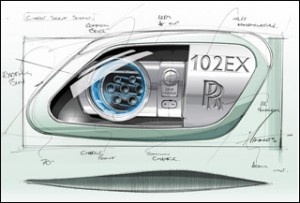Rolls-Royce goes electric


Rolls-Royce conjures up notions of uncompromising automotive luxury, but that focus does not prohibit it from also being environmentally friendly. Rolls-Royce Motor Cars will be unveiling a fully electric concept car at the Geneva Motor Show next month.
On March 1, the British manufacturer will unveil the 102EX, an eco-friendly edition of its venerable Phantom sedan. Rolls-Royce describes the vehicle as a “one-off,” and has this week launched a Web site to start a dialog about whether it should begin producing electric drive-trains.
The Web site poses the question: "Compromise or Luxury?" (Some compromise wouldn't hurt - the 2010 Phantom sedan's 453 hp V12 power plant gets an underwhelming 11 mpg city / 18 mpg hwy.)
“We have engineered the world’s first battery electric vehicle for the ultra-luxury segment,” CEO Torsten Müller-Ötvös said in a prepared statement. “With this vehicle, we begin an exploration into alternative drive-trains, seeking clarity on which alternative technologies may be suitable to drive Rolls-Royce motor cars of the future.”
The company has also announced its intention to also produce a plug-in hybrid. There is some speculation that it may deploy parent company BMW's recently unveiled hybrid "BMWi" drive-train. BMW will roll out two production vehicles under the brand in 2013.
The auto show commences a worldwide tour of the 102EX throughout Asia, Europe, the Middle East, and North America. Owners will be given the opportunity to test-drive the vehicle for market research purposes.
The Phantom's Web site will be used to promote the tour and provide the latest news and updates on the 102EX project.
Rolls Royce will be addressing issues commonly associated with electric vehicles, including range, but also seeks to maintain its upscale brand image.
“It must be a technology that is right for our customers, our brand and which sets us on a sound footing for a sustainable future,” Müller-Ötvös noted.
This post was originally published on Smartplanet.com